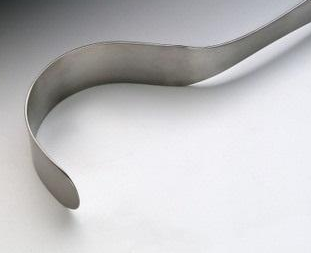Deaver Retractor Uses, Sizes, Function, Narrow & Wide
What is Deaver Retractor?
When doing abdominal or thoracic surgeries, a handheld surgical tool called a Deaver retractor is frequently utilized to hold back the abdominal wall. It is available in several variants with a broad variety of working end sizes and widths, and it has a question mark-shaped blade that is thin and flat.
Organs can be held or moved away from the surgical site using the retractor. The grip handle of the Deaver retractor, which is frequently grasped by a surgical assistant during procedures, may be flat or grip-shaped. The retractor is composed of high-quality stainless steel, making it easier to sterilize and reuse instruments.
Deaver Retractor History
At the beginning of the 20th century, American physician John Blair Deaver served as the head of surgery at the German Hospital in Philadelphia. He specialized in abdominal surgery and was a proponent of early appendectomy in cases of appendicitis. He authored five textbooks and over 250 articles.

Deaver Retractor Uses
The main purpose of the Deaver Retractor is to retract far into the body, like the chest or abdomen. This instrument is highly adaptable and can be utilized in many surgical procedures, such as neurosurgery, orthopedic surgery, thoracic surgery, and abdominal surgery.
Due to its thinness and flatness, the blade during surgery is less prone to tear or harm tissue. One hand can be used to operate the Deaver Retractor, freeing up the other for other surgical tasks. It is a simple tool to use.
Deaver Retractor Function
When doing abdominal or thoracic surgery, the Deaver Retractor is used to retract the abdominal wall and move or hold organs out of the way.
Deep retractions into the belly or chest are the main applications of the Deaver Retractor. It is a flexible tool that may be applied to many different types of surgical operations, such as neurosurgery, orthopedic, thoracic, and abdominal surgery. During surgery, there is minimal chance of tissue damage or trauma because the blade is thin and flat.
Deaver Retractor Sizes
Small Retractors (5-7 Inches):
Ideal for precise processes that necessitate careful handling.
Medium Retractors (8-10 inches):
Adjustable alternatives appropriate for a wide range of operations.
Large Retractors (11-13 inches):
Designed for larger surgical areas with plenty of view.
Deaver Retractor Narrow vs Wise
Deaver Retractor Narrow
The blade of the slim Deaver retractor is slender, flat, and curved. It is employed in deep abdominal and chest surgeries, such as cholecystectomy, which involves withdrawing the liver's right lobe. The thin Deaver retractor is used to pull back the abdominal and chest regions of deeper bodily tissues.
Deaver Retractor Wide
The flat blade of the wide Deaver retractor varies in width from narrow to broad. With a deep, curved blade that keeps bigger organs out of the operating zone, it is also utilized for deep wound retraction during abdominal surgery. Retraction of the deeper body tissues from the chest and abdomen can be accomplished with the wide Deaver retractor.
 Reviewed by Simon Albert
on
November 14, 2023
Rating:
Reviewed by Simon Albert
on
November 14, 2023
Rating:











